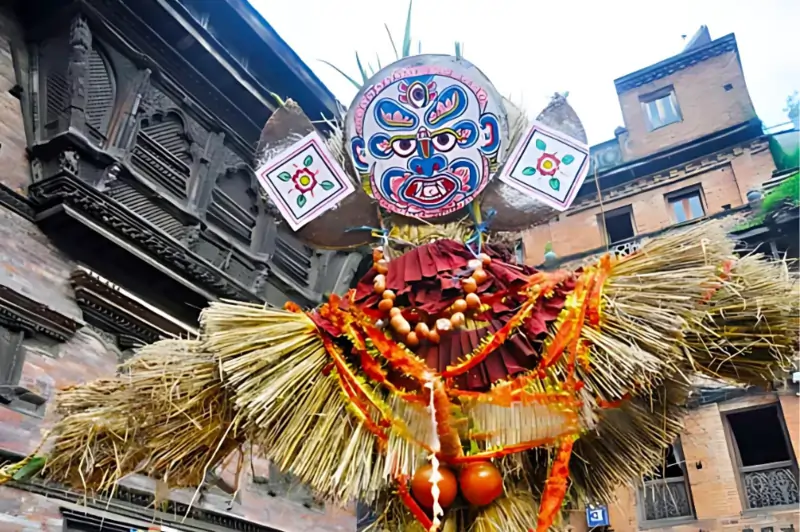Understanding the Historical Context
To truly understand the significance of Gathe Mangal, it is essential to explore the traditions and historical context of Kathmandu’s society during the ancient Malla period. The history of that era remains incomplete, as historians have yet to conduct an in-depth study of its literature, inscriptions, and other archaeological records. However, certain documented aspects of our history offer valuable insights into the prevailing social and religious mindset of that time.
The Shift from Vedic to Tantric Practices
Following the Licchavi period, Nepal underwent significant changes that impacted people’s religious beliefs, customs, and traditions. As a result, the educated elite of the Malla period transitioned from Vedic-based ideologies to esoteric Tantric practices. Rather than focusing solely on pure Vedic texts, people began to study and revere Tantric scriptures, which emphasized mystical rituals and mantras. This shift is not merely speculative; it is supported by the abundance of Tantric literature, temples, statues, and festivals that emerged during the Malla period. Many of these texts are still preserved in our libraries, and some statues and rituals continue to be part of our living tradition. These artifacts and cultural practices provide a clear picture of the religious and philosophical inclinations of that era.
Gathe Mangal as a Tantric Festival
Gathe Mangal, a monsoon festival, is a product of this Tantric influence. Though ancient Malla texts do not explicitly document the origins of the festival, it is mentioned in the Gopal Vamshavali, a historical chronicle from the reign of King Sthiti Malla. This suggests that the festival was already well-established as a tradition by his time. Since Sthiti Malla’s reign marks the beginning of the later Malla period, it is reasonable to infer that the festival originated in the earlier Malla era. This tradition likely does not date back to the Licchavi period, as the Licchavis were less inclined toward Tantric practices, even though they acknowledged the use of certain rituals like sacrificial offerings and medicinal chants.
Chaturdashi and Its Supernatural Associations
The observance of Gathe Mangal follows a distinct Tantric ritual system, which is both fascinating and symbolic. The festival takes place on Chaturdashi, the 14th day of the lunar fortnight, which aligns with ancient Ayurvedic texts that describe the influence of supernatural forces, including malevolent spirits, on human health. The Sushruta Samhita, an ancient medical text, dedicates an entire chapter to Bhoot Vidya (the study of supernatural afflictions). According to this text, various malevolent planetary forces, known as Grahas, affect people at different times, and the Pisacha Graha (demonic influence) is believed to be most active on Chaturdashi. Symptoms of those afflicted by Pisacha Graha include erratic speech, uncleanliness, nocturnal wandering, excessive eating, and raising their arms while walking—traits that are mirrored in the behavior of those embodying Ghantakarna during the festival.
The Origin of the Name “Ghantakarna”
The term Ghantakarna, which refers to a figure represented in the festival, has an interesting linguistic origin. The Gopal Vamshavali refers to him as Ganthakarna, which later evolved into Ghantakarna. In the Newar language, the syllable “Ga” signifies a bell, reinforcing the association with bells that are prominently worn during the ritual. However, whether Ghantakarna represents an actual historical figure or merely a symbolic depiction of an ancient belief remains a mystery. In traditional Bhoot Vidya, spirits do not have a defined physical form, yet in the festival, Ghantakarna is represented with an effigy bearing a painted skull symbol. This aligns with an ancient artistic convention where intangible elements, such as the sky or sound, are often depicted solely by a head or a facial representation, much like the numerous Akash Bhairava statues seen across Nepal.
The Ritual of Collecting Offerings
The practice of erecting Ghantakarna effigies at crossroads and collecting monetary offerings during Gathe Mangal suggests a historical effort to counteract a perceived supernatural threat. It is possible that, at some point in history, the influence of Pisacha Graha was believed to be so severe that a large-scale ritual was organized to dispel it. The tax-like collection associated with the festival may have originated as a means to fund such rituals, particularly in the Tantric-dominated Malla period. The money collected is traditionally used for the ceremonial disposal of the Ghantakarna effigy, reinforcing its role as a ritualistic practice aimed at driving away malevolent forces.
Ritualistic Practices and Supernatural Beliefs
Additionally, the Ayurvedic text on Bhoot Vidya prescribes methods for warding off supernatural afflictions, many of which persist in the festival today. One such practice involves offering one’s clothing as a sacrifice, which aligns with the tradition of placing cloth on the Ghantakarna effigy. Some individuals even create intricate doll-like figures from fabric and hang them on the effigy to prevent future supernatural disturbances. The festival also involves the offering of meat and blood sacrifices—practices historically believed to appease spirits.
Historical Significance of Gathe Mangal
Based on these elements, Gathe Mangal can be considered an ancient cultural tradition rooted in Aryan Tantric practices, though its prominence remained largely within the Kathmandu Valley. The festival likely commemorates a significant collective effort from the past to ward off supernatural influences, possibly led by Tantric practitioners who arrived in Nepal during the Malla period, fleeing political persecution in India. Given that Tantric rituals often incorporate medical and psychological principles to address ailments attributed to supernatural causes, it is likely that the festival originated as a widespread Tantric ritual rather than merely a folklore-based practice.
Conclusion
Thus, Gathe Mangal represents an intriguing intersection of medicine, mysticism, and cultural heritage. While its precise origins remain uncertain, its continued observance provides a living link to the ancient beliefs and practices that once shaped Nepalese society.
References
- Nepali Chad-Parbaharu Ko Bibechana, Mana Bajra Bajracharya, 1968

